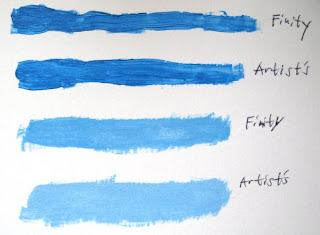About one year ago, Winsor and Newton replaced their venerable, top of the line Finity series of acrylic paint with the new Artist's Acrylic paint series. I've used exclusively Finity acrylic paints ever since I started painting since they performed well and were commonly available, so the discontinuation of my favorite paint brought some concern. As supplies of the old Finity paint dwindled in American hobby and craft stores, I bought up what I could and started to use the Liquitex line of acrylic paints for some colors. While the Liquitex paint performs well, I was eager to see how the new Artist's Acrylic paint would compare to the Finity series.
For whatever reason, it took close to a year since the release of the new paint series for it to show up in local hobby and craft stores - yet another advantage of online ordering is that one can get new products much quicker! Now, I finally have tubes of both the Artist's and Finity paint series to compare to each other. I've seen very few reviews of this new series online, so I figured I'd use this opportunity to test the new product myself and share my results.
Packaging and appearance: Both the Finity Series and the Artist's series paints come in 60 mL (2 Oz) squeeze tubes that are similar to toothpaste tubes. Unfortunately, the new series kept the small cap used on the Finity series; these small caps tend to gum up with paint easily, so keep them clean or they'll require a strong twist to open.
The Artist's series now displays a stripe of the actual paint on the tube's label so you know exactly what you are getting. IMHO, all paint should packaged in such a way since it gets past limitations of trying to represent the color through a picture on the label. This method also makes it obvious how transparent or opaque the color is; I have yet to see any series of artist's paint in which the colors have their opacity all accurately listed. This case is no exception to that rule. Cerulean Blue is typically listed as "opaque" even though from what I've seen it is "semi-opaque" in that it does not fully cover whatever is below it. For examples of truly "opaque" paint, look at Titanium White, any of the various opaque "Mars" colors (all forms of iron oxide), or any of the Cadmium based paints.
While not all of the paint colors translated directly over from the Finity series to the Artist's series, most did, and the pigments are all still accurately labeled and reflected on the label. Both the Finity and Artist's paints in this case have Cobalt Stannate (PB35) as the pigment. Neither one is a "hue" - a mix of other, often less expensive colors used for convenience. Hues of most expensive colors are still available in the new series, though each artist will have to see if those mixes meet their needs.
One odd note: the new Cerulean Blue is listed as Series 5 paint (the most expensive), while the older Cerulean Blue is listed as Series 4 paint. I've usually seen the Series 4 and 5 sold at the same price, but be careful of this; any of the Cobalt or Cadmium based paints are expensive, so keep your eye open for sales.
Performance: I performed two simple tests to compare the Finity series with the Artist's series. The first was to take a bead of paint from each tube and draw it out across a white piece of paper to check the color of the paint both in thick and thin layers and to see how quickly it dried. Both colors appeared basically identical, and both handled on the brush in the same fashion. The Artist's paint did take a bit longer to dry (maybe a minute or so), but not long enough to significantly change it's properties. In short, the new series still behaves in the traditional, quick-drying acrylic fashion, though you do have a bit longer to work with it. For artist's seeking truly "open" paints - ones that dry much slower and thus allow wet-on-wet techniques, you'll want to consider other series.
The second test was to mix the Cerulean Blue with Titanium White (Finity series) in a ratio that would approximate a sky blue color - painting skies is perhaps the biggest use of Cerulean Blue, at least in landscape art, so this seemed a good test. I was checking to see how well the new paint series would mix with the old one and if it would produce a good sky blue.
The Artist's paint worked fine with the older Finity line, producing a nice sky blue color that was about the same as the results of mixing the Finity series Cerulean Blue with Finity series Titanium White. The two colors displayed are not exactly the same, but since the mix ratios were approximated, this is not surprising. Note that the Artist's series is advertised as darkening less upon drying than other acrylic paints; this may be the case, but I haven't seen much darkening from my other acrylic paints, so it's difficult for me to see this improvement.
Summary: Based upon these straightforward tests, the new Artist's line of acrylic paints is a fine replacement for the Finity series and, of equal importance, should work fine with the older Finity paints.

